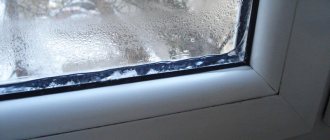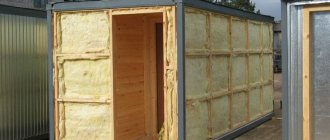Why do you need insulation?
Most of the heat loss in the house occurs through window openings.
The roof, floor and walls are significantly inferior in this indicator. Low temperatures are uncomfortable, significantly reduce the quality of life, and not only the comfort of home is lost. Along with the heat, money spent on utilities or heating natural resources also leaves the home.
Therefore, practical owners think in a timely manner about how to insulate double-glazed windows in plastic window structures. This will reduce housing maintenance costs and make life more comfortable.
Modern plastic windows, due to their materials and design features, are significantly superior to wooden ones in terms of thermal insulation and sound insulation. However, for a number of reasons these properties may be lost:
- installation errors;
- malfunction of fittings and fasteners;
- aging of the seal;
- improper insulation or destruction of the insulation material of the window sill, slopes, construction foam in installation joints;
- lack of season-appropriate pressure adjustment;
- deformation due to shrinkage of the building.
Another reason may be the low quality of materials used in the manufacture and installation of plastic windows.
Modern plastic windows are significantly superior to wooden ones in terms of thermal insulation and sound insulation.
Standardization of installation work
The greatest heat loss in a private house or apartment occurs through the roof, as heated air rises upward, and through the walls.
Cooling can be reduced by using an additional layer of building materials applied internally or externally. If large areas of flat surfaces are not difficult to insulate in the shortest possible time, then the window opening will require knowledge of special skills and materials. Windows in the house, namely the joints of blocks and openings, are the coldest places. Air from the street penetrates through the seams, and the junctions between the metal and the wall serve as cold bridges, which lead to a decrease in the temperature inside the room.
According to GOST standards for installing windows and connecting fastening points, metal-plastic blocks are not installed directly to a concrete wall. Blown-in foam is not considered insulation. Many manufacturers do not know about the correct installation of structures. Some try to save on materials and installation in this way.
Why does it blow from a plastic window?
Determining the reason for the blowing of a plastic window begins with whether it is new or old. In the first case, the problem can be safely attributed to poor quality installation of the product, which means that the installers will have to solve it.
In this case: poor-quality installation seam of plastic windows
Often, plastic windows are installed by companies whose workers do not have sufficient qualifications. Mistakes are also possible when trying to install windows yourself. That is why it is not recommended to save on specialists when replacing PVC windows with new ones. But if you are faced with a problem with improper installation or an obvious manufacturing defect, warranty repairs should cover all additional costs.
In the second case, the appearance of a draft is associated with the characteristics and duration of operation of the window. Among the reasons are:
- “Warpness” of the window frame and depressurization of joints due to shrinkage of the newly built house;
- Wear of window components - seals, sash pressing mechanisms, etc. after a long period of use;
- Untimely or absent maintenance of PVC windows.
Some of the problems can be fixed yourself, which will save both time and money. Others are best left to specialists. Namely:
- if replacement of fittings is necessary (“original” parts can often be ordered only through the installer);
- when performing external high-rise work (for windows located above the second floor);
- when insulating a window in winter (specialists will be able to do this quickly and without significant heat loss in the room).
With your own hands you can insulate the window from the inside or along the contour, replace the sealing material, and insulate the window sill.
Insulation by adjusting the plastic window
Elimination of distortion of the PVC window sash
To reduce heat loss, you need to adjust the fittings (components) of the window unit.
how to adjust the fittings of a plastic window and door
How to adjust plastic windows for the winter - video
Replacing the seal in plastic windows
Elimination of blowing of plastic windows is possible by replacing the rubber seal. You can change the seal yourself, everything is simple - just pull out the old seal and insert a new one into the groove (groove).
Which seal is better? Please note that there are window insulation in black and gray colors on the market. The black seal is more flexible, but the attractive light color is due to various additives that reduce the cost of the window seal and at the same time worsen its properties (tightness).
Replacing the seal in plastic windows - video
How to understand where it's blowing from?
Before you begin work on insulating a window, you should make sure that it is actually blowing from it. Very often, a room “freezes” for other reasons; the air circulation in it is disrupted - a cold flow moves near the windows, which creates the illusion of a draft.
There are several ways to determine the source of window ventilation:
- Tactile - in case of a strong draft, it is enough to move your palm along the perimeter of the window to feel the air movement;
- With the help of a lit match or candle, the light will begin to oscillate at the slightest movement of air;
- Using a paper sheet pressed by a closed sash - if the sheet moves easily between the sections of the glass unit, then the problem is in the seal.
It is necessary to check the window along the entire perimeter, as well as in the area under the window sill. It is also worth paying attention to specific details on the window, which most often cause drafts - the bead holding the glass unit, the rubber seal, fittings (hinges, handles).
Insulation of wooden windows for the winter from the inside
Let's consider the main methods of internal insulation of windows (thermal insulation from the room side), which can be divided into temporary and conditionally permanent. The first group of activities includes those that are carried out during cold weather and are removed in the spring by washing frames and windows. The second includes those that ensure the tightness of windows for a long period.
How can you insulate old windows?
- paper;
- cotton wool;
- foam;
- rubber or polymer seals;
- polyurethane foam;
- acrylic or silicone sealant;
- hard or soft insulation;
- paraffin, alabaster, etc.
How to insulate wooden windows with paper
This is the first option that comes to mind if you need to quickly and inexpensively insulate old windows. Of course, the aesthetics of the window suffers from this method, but the level of tightness is quite high. Material prepared for the website www.moydomik.net
To make paper putty, you need to shred the paper (it’s better to use old newspapers), soak it in water, squeeze it out, add 1 part clay or 2 parts crushed chalk to the mixture, and seal all the cracks with the resulting mass. The putty is flexible and easily clogged even into small cracks. To apply the mass, use a knife, screwdriver, metal ruler or other suitable tool.
To cover the paper putty, window tape or special paper with adhesive properties (such as masking tape), window paper or fabric strips are usually used. Fabric and paper are coated with soap soaked in water and glued over the cracks.
The insulation is kept in place until warmer weather sets in, and then removed. At the same time, unattractive stripes remain on the window that need to be washed off.
Note. If the decorative coating on the window does not hold up well, you need to be prepared for the fact that some part of it will be removed along with the tape or paper and painting will be required.
How to insulate wooden windows with cotton wool
The method is similar to the first, but instead of paper putty, cotton wool is used, which is also covered with strips of paper/fabric.
How to properly stick paper on windows - video
Insulation of windows with sealant (regular or tubular foam rubber)
Ordinary foam rubber is placed between the frame doors and closed. Foam rubber is distinguished by low price and availability. And also the possibility of reuse next season.
Insulation of wooden windows with foam tape
Tubular foam rubber is glued to the window frame from the inside using adhesive tape. The advantage of this method is the ability to use the window - open/close (for example, to ventilate the room). The seal holds securely on the sash and does not interfere with the operation of the window. In addition, it can be glued in several rows, which increases the tightness of the fit of the window sash to the frame.
A good option is self-adhesive window tape made of rubber, polyurethane or polyethylene foam, made in the form of tubes with an adhesive base.
Insulating old wooden windows with self-adhesive window tape
The choice of sealant depends on the temperature, quality of the material, and the size of the gaps. Learn more about window seals in the video
Insulation of wooden windows using Swedish technology
This is one of the effective ways of insulation using a sealant. The difference lies in the technology of its installation. In this case, before installing the seal, you need to make a groove in the frame and place the seal in it.
As you can see, Swedish technology is, in fact, a partial restoration of a wooden window. And, ordinary wooden frames in their heat-saving properties are close to metal-plastic ones.
Swedish technology for insulating wooden windows is in demand in Moscow and St. Petersburg, where residents of ancient houses that are part of the historical heritage. Many people do not want to switch to plastic and try to properly insulate wooden windows without changing their appearance.
Insulation of wooden windows with sealant or silicone
Clear caulk (acrylic) or silicone (silicone caulk) is applied either between the window frame and sill or between the frame and glass.
Thermal insulation of wooden windows with silicone
How to insulate wooden windows with sealant:
- glazing beads are removed from the frame;
- the seat is cleaned of debris, dust, and paint residues;
- the sealant is applied to the seat;
- After the sealant has completely dried, the beads are installed back. Users recommend using new glazing beads. Firstly, because old glazing beads often break during dismantling, and secondly, in this way minor repairs to the window unit are performed.
You can replace the sealant with a special putty for windows. The procedure for applying it will be similar, only instead of sealant, putty is applied, which is pressed tightly to the seat, leveled, its excess is removed with a knife, and after drying, the putty is painted over. Often, putty is applied inside the frame, between the glass, and on the side of the room, the place where the glass is installed is decorated with glazing beads.
Technology for insulating old windows with window putty
Insulation of wooden windows with polyurethane foam
The ability of foam to fill the smallest cracks has also found application in window insulation. Naturally, in order to be able to use the window, the foam is placed only between the frame and the wall. It is not suitable for sealing cracks between sashes. In addition, the foam needs protection, which requires the design of internal slopes.
How to insulate wooden windows with polyurethane foam:
- drywall blanks are cut to the size of the slope;
- the cracks are filled with foam;
- the slope blank is installed;
- insulation is laid between the drywall and the wall;
- the slope is primed and painted.
It is also advisable to insulate the window opening under the window sill using polyurethane foam.
Insulation of windows with heat-saving film
A new product on the market is heat-saving film for windows. The principle of energy-saving action is the ability to reflect infrared radiation, leaving it in the room. The film has different side coatings. When gluing, it must be oriented with the metallized side facing the street. In this case, the film is glued not only to the glass, but also to the frames. This technique increases the heat-saving properties of wooden double-glazed windows. Water is used as glue, and the main thing during the pasting process is to ensure complete adherence of the film to the surfaces, without bubbles or folds.
Insulating windows by eliminating cracks
Wood is prone to cracking when exposed to temperature changes. As a result of this process, the wooden frame and sashes of the window block are covered with a network of small cracks through which heat escapes. There are several ways to eliminate gaps in frames and between windows and sills.
How to seal cracks in wooden windows
- fill the crack with molten paraffin;
- use special putties;
- You can use self-prepared mixtures, for example, from building gypsum and crushed chalk in a 2:1 ratio.
- use sealant.
All of the above methods involve complete cleaning of the frame from old paint (decorative coating) and subsequent painting after insulation work has been completed. Painting the frame with oil paint also reduces heat loss through microcracks in the wood.
Advice. The use of wood putty or a gypsum-chalk mixture is invisible on the surface of the wood and allows the use of varnish as a finishing coat. Reviews indicate that it is problematic for paint to adhere to paraffin and sealant, so they need to be applied in a thin layer and the excess removed from the surface of the wood.
Combined window insulation
The technology involves using several methods simultaneously. More details in the video
Identifying problem areas
If you have problems with the tightness of plastic windows, you should find places where warm air leaks . First of all, it is necessary to exclude the presence of holes, cracks, and loose fit of the valves. Simple methods can be used:
- using a lit candle or a simple lighter - the flame will sensitively react by deflecting to the presence of the slightest draft;
- tactile - just run your palm along the perimeter of the opening and weaves, don’t forget the wall under the window sill: a stream of cold air will let you know about the presence of a through hole;
- open the flap slightly, insert a sheet of paper and close it again, now try to pull out the sheet, if possible - there is a problem with the tightness of the fit.
The problem may be hidden by slope panels or a window sill: perhaps the insulation material has collapsed , creating a void, and the heat-saving properties of the window are lost. Before dismantling the structural elements of plastic windows, conduct an inspection:
- Tap on the surface of the panel: if there are voids there, they will respond to tapping with a louder sound.
- Carefully check the tightness of the connection of the structural elements of the window; if you find any cracks, glue them.
- Make sure there is no deformation of the frame.
- Pay attention to cases of condensation, frost, and frost.
If you have problems with the tightness of plastic windows, you should find places where warm air is leaking.
Causes of heat loss - how to determine the source?
First, determine whether it is really blowing from the window opening. Often this is just an illusion, which can be explained simply. If a structure is installed that does not provide adequate thermal insulation according to its characteristics, then air circulation is disrupted during frost. The cold mass moves inside the room near the window. This suggests that heat is escaping through it.
To make sure whether this is true or not, take a burning candle and bring it closer to the point of contact between the window sash and the frame. When the flame deflection is noticeable, a leak has been detected through which heat leaks. If the fire is vertical, then the structure is sealed, and the reason is different.
Structural elements of a plastic window
With a candle, they pass the window opening around the entire perimeter, then they can definitely detect the defective place. More often it is located at the junction of the frame and the wall. The problem lies in poor-quality installation - it blows through the window sill, under which there are cracks, or through the slopes.
Window unit device
The most common reason is due to incorrectly adjusted fittings. The fault can be fixed easily and quickly, but if the equipment is of poor quality, it happens that nothing can be done. This applies to products produced underground. The cost is low, which attracts little-known domestic companies that choose such suppliers. Therefore, it is preferable to order designs from large companies that value their reputation.
If the window geometry is broken during assembly of the structure, the sashes do not fit tightly to the frame, and drafts appear. In this case, nothing can be changed; reinstallation is required, taking into account previously made errors. A master from a well-known company will never make such mistakes. For products installed at the beginning of the plastic products boom, this was a natural phenomenon, because the workers were recruited randomly without relevant knowledge and experience.
Poor quality window seals also cause cold to penetrate into the room. Good material can withstand frost and heat for many years without losing its elasticity. A dirty surface leads to the same consequences. Damaged products are replaced with new ones.
Cheap plastic is sometimes used to make plastic windows. It is quickly destroyed from the outside under the influence of ultraviolet rays and elevated temperatures. In the winter season, cracks appear on the profile, through which cold penetrates into the room. The product cannot be repaired and must be replaced.
We recommend
- How to insulate wooden windows for the winter with your own hands
- Plastic slopes on windows and doors - quick installation of panels with your own hands
- How to lay tiles on the floor correctly - do-it-yourself technology
How to insulate plastic windows with your own hands?
Photo: Bigl.ua
How to insulate windows cheaply and effectively? Despite the apparent complexity of the activities, it is quite possible to do the following on your own:
- carry out internal insulation of the window opening;
- insulate the window sill and frame along the contour;
- replace seals.
Insulate plastic structures before the onset of frost, since some materials, including sealants, are used only in a certain temperature range.
Photo: 3brothers.ru
The type of insulation depends on the location of the blowing:
- Polyurethane foam is used to fill voids around the perimeter. This is an ideal seal, as it consists almost of air;
- mineral wool is a heat-insulating material suitable for insulating window sills and slopes;
- expanded polystyrene is used as slope insulation.
Please note that rigid insulation is used only when the seam width does not exceed 3 mm. In other cases, give preference to mineral wool
Do not use adhesive tape for insulation purposes - it is very difficult to wash off the surface.
When insulating yourself, follow this algorithm:
Carry out internal insulation
Pay attention to internal slopes. Don't forget that they must be aesthetically attractive
To do this, treat them, remove the remnants of old foam and apply a primer. Seal the cracks with polyurethane foam, then use polystyrene foam or cotton wool. Install drywall or paint the surface. Insulate the window sill by sealing the cracks.
Insulate slopes and ebbs from the outside
This is necessary to shift the dew point and prevent the development of mold. First, clean the slopes of dirt, then use high-quality rigid insulation. It is also important to seal all cracks with glue and finish plaster. When insulating ebbs, it is enough to blow foam into the cracks.
Adjust window mechanisms
To reduce heat loss, adjusting the fittings is important. Replace the seal if necessary. Please note that black material is much more elastic. But light gray is more attractive, but its tightness is lower.
Photo: yandex.kz
In addition to the main methods of insulation, additional ones will also help. Regular window cleaning will help reduce heat loss. This is due to the fact that sunlight passes through dirty glass less easily. Thick, long curtains will also help, helping to retain heat inside the room.
After completing all the work, do not forget to regularly ventilate the room or install forced ventilation, which will prevent mold on the walls.
In what places does a plastic window let the cold in?
A burning candle should be held along the entire perimeter of the window opening. This is the only way to accurately identify a defective area that will allow cold to pass through in winter. It is most often located at the junction of the wall and the frame. The reason for this phenomenon is poor-quality installation. The wind can also blow through the window sill, which has cracks. Cold air can penetrate through slopes or a loosely pressed sash, as well as a poorly assembled second chamber of a double-glazed window, which can also let cold in (this can be seen when your double-glazed window fogs up inside).
Poorly constructed window unit
The most common cause of air leaks is improperly adjusted fittings. It's easy to fix the problem even with your own hands. But, if the components were initially of poor quality, then this causes certain difficulties. This can happen if the products were manufactured underground. Due to their low cost, they are purchased by unpromoted domestic companies. Based on this, the conclusion suggests itself that you should order plastic windows from trusted individuals who have already acquired a good reputation in the market.
Don't miss: How to heat a coal stove in your home correctly?
If during the assembly of the structure the geometry of the window is disrupted and the sashes do not fit tightly to the frame, this may cause drafts to appear inside the room. This situation cannot be corrected; only a complete reinstallation of the structure will help without repeating previously made mistakes. If you hire a specialist from a trusted company, then such problems will not arise.
Heat loss in a room can occur if poor-quality insulation is installed. When good material is used to create a structure, the cold does not penetrate into the apartment. It is resistant not only to low but also to high temperatures. High-quality material lasts a long time, and its elasticity is not lost over a short time. A dirty surface can also cause heat leakage. To solve the problem, you need to replace the defective parts.
Some manufacturers use cheap, low-quality plastic to make windows. It is not resistant to sunlight and high temperatures, so it quickly deteriorates, they turn yellow, and in frosty weather cracks appear on the profile. The cold passes through them into the room.
Such products cannot be repaired. In this case, only replacing window structures can help.
How to check the condition of rubber seals?
The condition of the gaskets has a direct impact on the degree of air permeability. Therefore, they need to be looked after periodically, lubricated with special products:
- silicone-based lubricant;
- technical Vaseline.
Thanks to the lubrication of the seals, the original properties of Euro windows can be preserved for a fairly long period. When the gaskets are deformed, the window blows out, the rubber bands crack or extend beyond the frame, then they need to be replaced. The gasket is cut into suitable pieces and glued. You can use it as:
- rubber seals;
- self-adhesive gaskets.
Attention! Gaskets must be changed before cold weather sets in.
Before sealing the window frames, you need to clean them using a special product.
Sealant
Sometimes it is necessary to replace the seal on the frame or sash of a window. Changing rubber bands on plastic windows is not difficult. To do this, you do not need to use special adhesives. The rubber base is fixed in grooves located in the plastic profile. The old rubber band is removed. To make your task easier when inserting insulation into the grooves of the frame or sash, the latter can be treated with a soap solution. It should be laid in one contour. It is important to take accurate measurements and leave a small margin. It is better to choose black PVC insulation. Insulation of a different color, as a rule, does not have such a strong and elastic texture and deteriorates faster.
Sometimes you have to change the rubber seal that holds the glass unit in place. To do this, the plastic beads along with the glass unit are removed. Dirt and dust are removed from the adjacent areas. Only after this can the insulation and double-glazed windows be installed.
Attention! Before changing the insulation, you can try to switch the sash to winter mode or adjust the pressure.
Instructions for insulating windows
First adjust the tightness of the frames. Tighten the clamping mechanisms with a flat screwdriver so that there are no gaps left when closing, turn the pins clockwise until they stop. Then adjust the pressure on the top and bottom loops. After tightening, check the smooth movement of the frame, if necessary, repeat all of the above again.
The cause of a draft may be a worn rubber seal. To replace it:
- Remove the frame by removing the trim, retaining ring, and pin from the top hinge.
- Place the frame on a flat surface, remove the cover, and then the handle itself by unscrewing 2 screws.
- Remove the rubber seal and clean the grooves from dirt and dust.
- Degrease the plastic surface and place a new seal in the groove with the bend facing the sash. Press the rubber firmly. The cut points should be adjacent to each other without gaps; if necessary, trim the seal with a knife.
- Cover the new rubber gasket evenly with the silicone insert. Repeat the procedure annually before the start of the cold season.
- After replacing the seal, screw the handles into place and tighten the screws until they stop. If it is cracked, replace it. Lubrication will help improve smooth running.
If cold air comes from under the window sill, you can quickly fill the cracks with foam. It is not necessary to remove the window sill:
- First remove the plaster and remaining insulation. Thoroughly clean the surface from dust.
- Distribute the polyurethane foam evenly, be sure to treat the corners and bevels. To prevent the foam from moving the window sill, place heavy objects (cans of water, books) on it, and control the position with a building level.
- After foaming, dry the treated areas and cut off the dried foam with a sharp knife.
- Apply putty and a layer of plaster to the wall.
If it blows from the cracks between the plastic frame and the window sill, carefully fill them with quick-drying silicone sealant. Beforehand, thoroughly clean the joints from dirt and dust.
A special shrink film, which is glued to pre-washed and dried glass, will help to insulate the window:
- Apply construction tape around the perimeter of the frame.
- Cut the film to the desired length. Glue the canvas, pressing tightly with your hands.
- Treat the surface with a hair dryer. Jets of warm air smooth out the film and firmly fix it on the glass.
A properly insulated window is the key to a comfortable temperature in the room. The procedure is recommended to be carried out before each cold season. Preventive maintenance will help you save on expensive repairs.
Choosing material
Let's consider how to insulate a plastic window by choosing the optimal type of material. The determining factors when choosing how to insulate plastic windows are affordability, ease of use, durability, and safety.
Construction polyurethane foam:
- plastic effective material;
- affordable price;
- ease of use;
- susceptible to destruction under the influence of ultraviolet radiation , needs protection with facing material;
- budget option for insulation;
- over time it collapses and “sags”, is sensitive to temperature changes;
- It is better to choose high-density material, it is more resistant to destruction;
- low safety class; reliable cladding is required.
Basalt (stone, mineral) wool:
- excellent thermal insulation properties, suitable for internal and external insulation of plastic windows;
- elastic, durable material;
- fireproof and environmentally friendly.
Penoplex:
- a modern version of insulation made from extruded polystyrene foam, endowed with excellent properties;
- superior to foam both in characteristics and price.
Materials for window insulation.
A new inexpensive, easy-to-use material is gaining popularity - heat-insulating film for insulating plastic windows . It is glued directly to the glass and allows you to effectively insulate damaged double-glazed windows in any plastic windows. Energy-saving properties are provided by a special metal-containing coating that reflects infrared radiation and does not release heat. Strengths:
- electrostatic (does not attract dust);
- tolerance to household chemicals;
- transparent, thin, invisible canvas;
- does not glare;
- good size range;
- affordable price;
- ease of application.
Among the few disadvantages is a short service life; after 2 years it will require replacement.
A new inexpensive, easy-to-use material is gaining popularity - heat-insulating film for insulating plastic windows.
Window insulation
Most often we leave the house through uninsulated windows. It also happens that cold air from the street penetrates through the cracks, which is why there are drafts in the room, and the heating radiators do not cope with their task. We suggest starting the problem of heat conservation with window insulation.
Radical measure
One of the reasons for a cold apartment is windows that let air through. This problem can be solved simply - double-glazed windows or modern wooden frames are installed. The latter, by the way, are very reliable and practical. The wooden frames of such windows are made from laminated veneer lumber. Compared to solid wood frames, they do not crack or deform even in the event of sudden changes in humidity. However, they also have a significant drawback - they are expensive. PVC windows will be cheaper.
Frame insulation
What to do if it is not possible to replace windows? The frames will have to be insulated. This process is not unusual and is familiar to many.
Previously, cracks in windows were sealed with newspapers, paper or cotton wool. Today everything is much simpler: stores sell special tapes that are designed specifically for insulating window frames. These sticky strips are simply used to cover window frames around the perimeter. This simple procedure allows you to retain heat inside the house and prevent cold air from entering the room.
Before you begin insulating the windows, the frames should be washed and degreased. When the surface is dry, you can glue the tape to it.
By the way, if you wash the glass at the same time, the windows will let more sunlight into the rooms, and therefore more heat.
Film for glass
To insulate wooden and plastic windows, a special film has also been invented that needs to be glued to the glass. It is transparent, very thin and can be similar to polyethylene. This means that the material transmits light well into the room, but at the same time “works” as another glass. Simply put, the film becomes an additional barrier to cold and wind.
There are quite a few options for energy-saving films. For example, there are specimens that have a reflective coating. In winter, a window covered with such a film does not let heat out of the house, and in summer it reflects the hot rays of the sun.
By the way, materials from this series also protect windows from prying eyes: from the outside, the glass looks like tinted glass. At the same time, the degree of their transparency for the residents of the house remains virtually unchanged.
If in winter you hardly ventilate a room with “cold” windows, you can cover the entire structure with insulating film by attaching the material to the frame around the entire perimeter. If you periodically open windows, glue the film in the traditional way - on the glass.
When the culprit is old window sills
Cracked window sills can also cause heat loss. Cracks are quite easy to repair with regular foam. The option is budget-friendly, but not very aesthetic, so as an alternative, you can use a solution of plaster, chalk and water. Against the background of light windows, such a composition will not be too noticeable.
Another way is to use decorative pillows. You can buy them or sew them yourself. The main thing is that they completely cover the joint between the window sill and the frame. This will prevent the wind from entering the room in a strong stream, and the interior will be complemented by a beautiful decorative element.
You may find the information useful on how to change the window sill of a plastic window.
What about the slopes?
The space around the window can also give off heat. In this case, you will have to do a mini-repair: cover the window opening with a layer of primer and install overhead slopes. Often this finishing is done after installing new PVC windows, but slopes can also be made simply to insulate the window area.
Overhead plastic panels are filled with heat-insulating material from the inside, so they are excellent for insulating the space around windows.
How about new curtains?
An auxiliary protection against drafts will be curtains made of thick material, covering windows and openings as much as possible, and also reaching the very floor. Of course, they will not be a panacea for the “walking” wind, but they can be very useful as an additional measure of protection against it.
How to stick film
With the help of energy-saving film, you can achieve noticeable results in heat conservation. Let's consider the algorithm for applying this material to a plastic window:
- You will need a film slightly larger than the window block.
- For fastening, take a special transparent double-sided tape and cut it off with a small margin.
- Thoroughly clean and wash the surface of the glass and plastic elements of the window.
- Place a strip of adhesive tape around the perimeter of the frame.
- Straighten a piece of film (cut with an allowance of 1.5-2 cm on each side).
- Remove the protective layer from the tape on the top bar.
- Apply the top edge of the film to the tape.
- Stretch the coating so that it does not come into contact with the glass; make sure that the tension is not too strong - the film breaks.
- Starting from the top, gradually remove the top layer from the adhesive tape and apply the film to it.
- Secure the bottom edge of the covering.
- Using a regular hairdryer, heat the film evenly over the entire area.
Cover a large window area with new material using two people. Remember, during the gluing process, the film should not come into contact with the surface of the glass unit ; it should not be stretched too much to avoid tearing.
As a result of the last manipulation, the film is stretched, leveled, and becomes transparent and matte. Any owner can insulate double-glazed windows in plastic windows in this simple way.
The film should not come into contact with the surface of the glass unit.
How to insulate a plastic window
Since there are many reasons for blowing through window structures made of metal profiles, there are also several solutions. The key to maintaining heat in a room is to follow all the details in the process of eliminating warm air leaks.
How to insulate double-glazed windows in plastic windows by replacing the seal
If you periodically treat the seal or edge around the perimeter with a special softening compound, it will last a long time. Otherwise, it dries out and cannot perform the tasks assigned to it. To successfully replace the seal and ensure the tightness of the metal profile window structure, it is recommended to adhere to the following technology:
- Remove the decorative plastic plugs from the hinges.
- Use pliers or a screwdriver to remove the pins.
- Carefully tilt the plastic frame and remove it from its hinges.
- Remove the old seal from the groove and replace it with a new one.
- Perform the above steps in reverse order.
How to insulate plastic windows to prevent it from blowing by adjusting the clamping mechanism
If the pressure density of the window mechanism is poor, the sealing of structural elements deteriorates, which leads to drafts. To adjust this mechanism with your own hands, just use a 4 mm hex key. The entire process of adjusting the pressure occurs in the following order:
- Find the eccentrics on the inside of the plastic sash; they look similar to nuts with a rounded edge.
- Using a hex wrench or pliers (it all depends on the hardware manufacturer), tighten the eccentrics clockwise.
- The notch should be directed towards the seal (inside the window). This indicates increased pressing of the mechanism. If the notch is outward from the frame, the mechanism will be weakened.
Important! When adjusting the pressure, the main thing is not to overdo it, otherwise there is a high probability of compressing the seal and disrupting the functioning of the mechanism.
Not only the clamping mechanism, but also the hinges are responsible for sealing the plastic window. To adjust them, you need to extend the hinge tongue to the maximum possible limit using a hexagon.
If the loops are left-handed, then the tool should be turned counterclockwise, and if the loops are right-handed, then in the opposite direction. In most cases, deterioration in clamping occurs due to a bead that has worn out. To replace it, you need to remove the old one using a spatula or knife and install a new one. Here it is important to use a completely similar product, of the same thickness and dimensions. Insulation of a single-chamber double-glazed window occurs in the same way - by adjusting the fittings.
How to insulate a plastic window sill with your own hands
To eliminate the leakage of warm air through a plastic window sill, you need to know several points that contribute to the penetration of cold into the room:
- It can blow through the space located between the window sill itself and the wall. This will require dismantling the window sill and adding insulation for plastic windows (thermal insulating material), or completely replacing it. Upon completion of the work, the distance between the plastic window sill and the wall must be foamed.
- Heat loss can occur in the line of contact between the window sill and frame. This is due to an insufficiently precise fit of the structure relative to the available space, or a lack of insulation. This is where sealant comes to the rescue.
Don't miss: Chicken coop for the winter: how to insulate it yourself from the inside and outside, budget insulation materials
Insulation of seams of plastic windows
The seams can be sealed using either sealant or liquid plastic. The work algorithm itself provides for:
- Degreasing the surface, for example, with alcohol.
- Apply sealant to the surface after the degreasing solution has dried. To ensure an even seam, use a nozzle that is placed on the tube. Squeeze out the mass slowly so that the strip is thin and lies exactly along the seam line. If you do this in large quantities, it will be difficult to remove excess and grout.
- Walk along the line of sealant with your index finger; before doing this, protect your hand with a glove. For efficiency and accuracy, the finger should be moistened. If there are drops of silicone on a plastic window sill, then, without waiting for them to dry, you need to remove them with a wet cloth. A special spatula is also suitable for these actions.
It is recommended to carry out such manipulations not only when an urgent need arises, when it is blowing from the window, but also periodically, after a couple of seasons. Both temperature fluctuations and ultraviolet radiation have a detrimental effect on grout.
Insulation of slopes of plastic windows
The arrangement of slopes not only performs a decorative function, but also prevents the penetration of cold air through the cracks into the room. It is best if the slopes are insulated not only from the inside, but also from the outside. The sequence of work is as follows:
- Cut off unnecessary parts of the polyurethane foam.
- Treat the uneven surface with a plaster compound.
- Apply a primer to the surface of the slope, which will prevent the formation of mold.
- According to specific dimensions, cut out fragments of polystyrene foam and glue them to the surface of the slope, fitting it tightly. For reliability, you can use dowels.
- Mount the corner, apply putty to the surface and fix the casing.
By adhering to a simple technology for insulating slopes, you can forget for a long time about such troubles as the penetration of cold air through a metal profile window into the apartment.
Internal insulation of plastic windows
Insulation of windows from inside the room is carried out in the following areas:
1. Insulation of internal slopes of plastic windows
Internal slopes are less susceptible to the influence of external factors, but put forward more demands on the aesthetic component. Therefore, it is important to know how to insulate the slopes of plastic windows without losing the attractiveness of the window.
Work order:
- treatment of cracks: removal of dirt, removal of old foam, falling parts, etc.;
- applying a primer;
- sealing cracks with foam;
- removing excess foam after it dries;
- installation of thermal insulation materials (foam or cotton wool);
- installation of drywall;
- finishing drywall with putty and paint.
Insulation of the window sill of plastic windows
The gaps between the wall and the window sill are one of the places of significant heat loss. Before deciding how to insulate the window sill of a plastic window, you need to determine its weak point, i.e. where is it blowing from? For example, blowing is possible between the plastic parts of the window and window sill. In this case, it is recommended to use a sealant.
Heat loss between the window sill and the wall is also possible. In this case, insulation is carried out before installing the window sill by laying a layer of heat-insulating material. And also after its installation - by foaming the distance between the window sill and the concrete wall or brickwork.
Insulation by adjusting the plastic window
Elimination of distortion of the PVC window sash
To reduce heat loss, you need to adjust the fittings (components) of the window unit.
how to adjust the fittings of a plastic window and door
How to adjust plastic windows for the winter - video
Replacing the seal in plastic windows
Elimination of blowing of plastic windows is possible by replacing the rubber seal. You can change the seal yourself, everything is simple - just pull out the old seal and insert a new one into the groove (groove).
Which seal is better? Please note that there are window insulation in black and gray colors on the market. The black seal is more flexible, but the attractive light color is due to various additives that reduce the cost of the window seal and at the same time worsen its properties (tightness).
Replacing the seal in plastic windows - video
What else can be done to insulate a plastic window?
The methods described above will allow you to reliably insulate plastic windows and get rid of all the cracks, but it is possible to make the structure even warmer - it will not only not let cold into the apartment, but will also prevent warm air from leaving the apartment. This is not magic, but reality, which is achieved through the use of:
- heat-saving film;
- electric window heating;
- wool blinds and curtains.
Heat-saving film is a thin transparent material that does not change the optical properties of glass, but reflects thermal energy back into the apartment. The effect is achieved due to the presence of a thin metal layer. Of course, when it comes to plastic windows, it is better to use a special heat-saving double-glazed window - its efficiency is several times higher than any film, but if a regular double-glazed window is installed in the existing windows, then additional insulation will not be superfluous.
You can easily do the installation of the film yourself:
- the surface of the glass and frame are thoroughly cleaned;
- double-sided tape is glued around the perimeter of the box;
- The required fragment is cut from the film roll; it is better to cut with a margin;
- the film is glued to the previously attached double-sided tape, its surface is blown with warm air from a hairdryer. It is necessary to act slowly so that the result is accurate and there are no distortions or bubbles. Correctly applied film is almost invisible.
electric glass heating ; it is better to do this at the stage of window installation, but most window companies can install such a system on an already installed window. Heating is carried out by an electric heating coil built into the glass.
Well, and finally, the most banal, simple and universal ways to make a window a little warmer. These are thick curtains and wool blinds . The latter can be done by wrapping ordinary blinds with woolen fabric.
It is better to carry out work on insulating plastic windows on a warm, dry day, since many materials can no longer be worked at temperatures below +5...+100C, and you can let the cold into the apartment. In order to face the problem of insulating a modern window as soon as possible, it is worth taking the choice of a window manufacturer as seriously as possible and paying attention to the selection of optimal technical characteristics, focusing on the climate of the region. It is also important to choose a responsible installer and remember to properly maintain the window.
Insulation of slopes of plastic windows
The first step to increasing the thermal insulation properties of the window. No matter what insulation measures are taken in the house, until the slopes from the street are insulated, the cold will still flow inside. At the same time, external insulation allows you to shift the dew point, which will prevent the appearance of dampness and the development of fungus. Covering the cracks is a temporary measure, because... Over time, the layer of plaster will begin to crack and expose the mounting foam, which will collapse under the influence of atmospheric conditions. How to make window frames for plastic windows with your own hands. If you are still asking yourself the question of how plastic windows for a balcony are like ordinary windows. But as protection for insulation, plaster is an excellent solution.
How to insulate the slopes of plastic windows from the street
Work order:
- preparation of material (rigid insulation);
- cleaning slopes from dirt and protruding parts;
- surface primer;
- installation of insulation on an adhesive solution or special adhesive foam. It is preferable to use foam because it eliminates wet work, has a minimum setting time, and holds the insulation sheet more securely;
- sealing all cracks with glue;
- installation of perforated corners;
- installation of polymer mesh;
- finishing with plaster.
Main mistakes
When carrying out work on sealing plastic windows that have lost their heat-protective properties with their own hands, inexperienced owners make typical mistakes:
- dismantle, change structural elements, components and fittings during the period of validity of the manufacturer’s and installer’s warranty; During the warranty period, invite specialists to eliminate defects;
- when replacing mechanisms and accessories, “non-original” repair kits are used;
- begin to eliminate defects with the onset of frost; it is better to do repairs in the warm months or, at least, on a dry, windless day;
- show negligence in identifying gaps and voids, seal seams and voids poorly.
Important! Failure to comply with the technology for insulating plastic windows and the use of low-quality materials leads to constant problems and discomfort for residents.
Energy-saving film on glass
Energy-saving film is a very thin transparent material with a layer of rare earth elements applied to it. It is practically invisible on the windows and does not affect the level of illumination. The film can reduce overall heat loss through windows by 30%.
When choosing it, you first need to find out the coefficients of light transmission and heat reflection, and the wavelength range. Another important point: the heat-saving film does not allow UV radiation inside, which is necessary for the life of plants, so green friends will need to organize additional lighting.
Based on the installation method, a distinction is made between shrink film and that which is applied wet. To glue heat shrink material, you must perform the following steps:
- Prepare the window by washing and degreasing the glass.
- Apply double-sided tape to the edges of the sash or frame.
- Attach the film to the adhesive tape without pulling too much.
- Heat the surface with a hairdryer so that the film shrinks and stretches, forming a flat surface.
With the wet method, the glass is also first washed with window cleaner and degreased with alcohol or gasoline. Then the film is cut, leaving no reserves. Moisten the surface of the glass with a soap solution (colorless shampoo or other detergent will do). A piece of film begins to be glued on top and smoothed from the center to the edges.
You can also insulate balcony doors using shrink film.











